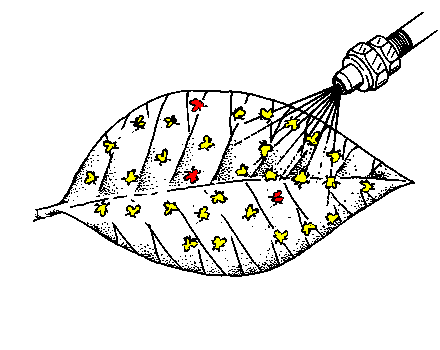Resistance to Pesticides
Although pesticides are designed to kill pest populations, they are seldom 100% effective — a few individuals usually survive and reproduce. These survivors may have a behavioral trait that helps them avoid the pesticide, a biochemical trait that allows them to detoxify the pesticide, or some other genetic characteristic that reduces their susceptiblity to the pesticide. If these survivors mate and pass on this “resistance” to their offspring, then subsequent generations will contain fewer susceptible individuals.

Eventually, the entire population may become “resistant”. There are two major variables that determine the rate at which a resistant trait is likely to spread throughout the population:
- Its mechanism of inheritance (dominant, recessive, or co-dominant; sex linked, pleiotropic, or polygenic), and
- The severity of selective pressure (what percentage of susceptible individuals survive each generation and whether mortality occurs before or after the susceptible individuals reproduce).
In general, resistance will spread through a population most rapidly when it is inherited as a single, dominant allele and selective pressure is high (meaning very few susceptible individuals escape and reproduce).
Class Resistance and Cross Resistance
When an insect population develops resistance to one pesticide, it may also prove to be resistant to similar compounds that have the same mode of action. This phenomenon, known as class resistance, occurs frequently in pest populations that develop resistance to organophosphate, carbamate, or pyrethroid insecticides. In some cases, a population may develop a form of resistance that protects it from compounds in more than one chemical class. This cross resistance may produce a population that can no longer be controlled with chemical insecticides.
Resistance Management
Frequent and/or indiscriminant use of chemical insecticides typically leads to the development of resistance and to a need for more powerful poisons. But wise use of pesticides can delay (or maybe even prevent) the evolution of resistant genotypes. There are basically three strategies that can be used to “manage” the resistance problem:
1. Management by Saturation involves excessive, heavy, or frequent use of a pesticide that is designed to leave absolutely no survivors. This strategy overwhelms a population’s resistance, suppresses any detoxification mechanism, and precludes reproduction by survivors. It is most effective when the resistant gene is dominant and the target population is small, isolated, or living in a limited habitat (e.g. greenhouse).
2. Management by Moderation uses only the minimum control necessary to reduce a population below its economic threshold. Growers use low rates, short-residual compounds, infrequent applications, and/or incomplete coverage to ensure that significant numbers of susceptible individuals survive and reproduce. This strategy tries to ensure that susceptible genes are never eliminated from the population. It works best when the susceptible trait is dominant over the resistant trait.
3. Management by Multiple Attack involves the use of several control tactics that work in different ways. By rotating insecticides with different modes-of-action or by alternating chemical with non-chemical control tactics, a pest population is exposed to selective pressures that change from generation to generation. Natural selection for a resistant genotype is less likely to occur when selective pressures are highly variable.

